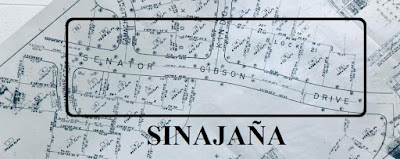 |
| Courtesy of Mayor Hofmann |
SENATOR GIBSON DRIVE
Growing up in Sinajaña, I've always heard of Senator Gibson Drive.
It's one of the village's main streets, taking you down to Hagåtña or out to Route 4 to Ordot and beyond. When Route 4 to Hagåtña is blocked or slow for some reason, Senator Gibson Drive is an alternative route.
But who was Senator Gibson? I always paid attention to elections since the 1970s, and never heard of anyone named Gibson running for the Legislature.
Since the street was in Sinajaña, I thought there was a Senator named Gibson who was from Sinajaña, but I never heard of any Gibson family in Sinajaña.
Well, here's the story.
SENATOR ERNEST W. GIBSON, SR
Ernest Willard Gibson, Sr was a US Senator from Vermont. He represented that state in the US Senate from 1933 till his death in 1940.
He was Republican, but a progressive one and backed many efforts to fund Guam projects and extend civil rights on the island, such as representative, civilian government and US citizenship for Guam's people.
So it was at Gibson's doors that BJ Bordallo and Francisco B. León Guerrero knocked when the two Guam spokesmen went to Washington, DC in 1937 lobbying for US citizenship. Gibson introduced a bill but it died in the face of Navy opposition.
Still, the Guam politicians considered Gibson a friend of Guam and showed their appreciation in the usual Chamorro ways; sending him an ifit wood cane with the Guam seal on the handle; a lamp with a shade made from transparent sea shell fetched at a depth of 1500 feet; a machete with accompanying sheath.
But the highest gift bestowed on Gibson by Guam's politicians in the Guam Congress was to have the island's only highway named in his honor in 1938.
That highway was perhaps Guam's longest stretch of road, starting in the capital city of Hagåtña, passing through Sinajaña, Ordot, Chalan Pago, Yoña, Talofofo, Inalåhan, Malesso' and ending in Humåtak. That is one long road, now called Route 4. No wonder they called it a highway, although it was just a two-lane road.
It was the first time a Guam road was called a highway.
We moderns think of wide, paved roads with four or more lanes and higher speed limits when we hear the word "highway." But the older meaning of highway was the main road from one town to another. Guam in 1938 didn't have modern highways. The older meaning was meant in "Senator Gibson Highway."
If you look at the pre-war map, you can see how the highway leaves Hagåtña and goes through Sinajaña, just a small, one-street village at the time.
PRE-WAR SINAJAÑA
AFTER THE WAR
After the war, what was known before as Senator Gibson Highway became Route 4. Only the Sinajaña portion of the highway was still called Senator Gibson, but often times Road or Drive. This remnant of the prewar highway was residential and could not be a modern highway, with high speed limits.
In 1978, Senator Antonio M. Palomo introduced a bill, later passed into law, renaming Senator Gibson Drive Pale' Kieran Hickey Drive in honor of the Sinajaña pastor who built Saint Jude Church.
And yet, though many people do call it Pale' Kieran Drive, other people to this day still call the street Senator Gibson Drive. Old habits die hard.
FROM 2001
Twenty-three years AFTER the name of the street was changed, some people were still calling it Senator Gibson Drive.
Only the tail end of old Senator Gibson Drive, which ends in a cul-de-sac, retains the Vermont Senators' name, called Senator Gibson Court up to this day. At least the half-dozen families who live on Senator Gibson Court will know why their street is so-named, if they read this blog.








Mayor, my high praise to you for researching and presenting all this to us. Very informative and honor bestowed on Senator Gibson.
ReplyDelete